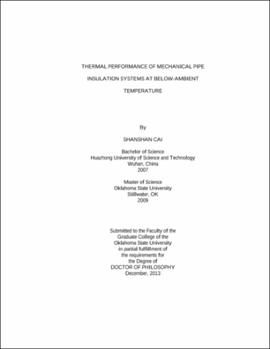| dc.contributor.advisor | Cremaschi, Lorenzo | |
| dc.contributor.author | Cai, Shanshan | |
| dc.date.accessioned | 2015-06-17T20:05:06Z | |
| dc.date.available | 2015-06-17T20:05:06Z | |
| dc.date.issued | 2013-12 | |
| dc.identifier.uri | https://hdl.handle.net/11244/14750 | |
| dc.description.abstract | Mechanical pipe insulation systems are commonly applied to cold piping surfaces in most industrial and commercial buildings in order to limit the heat losses and prevent water vapor condensation on the pipe exterior surfaces. Due to the fact that the surface temperature of these pipelines is normally below the ambient dew point temperature, water vapor diffuses inside the pipe insulation systems often condenses when it reaches the pipe exterior surfaces. The water droplets accumulated in the pipe insulation system increase its overall thermal conductivity by thermal bridging the cells or the fibers of the insulation material. The moisture ingress into pipe insulation threatens the thermal performance and the overall efficiency of the building mechanical system. | |
| dc.description.abstract | The main objective of this research was to investigate the effects of water vapor ingress on the thermal conductivity of pipe insulation systems. A critical review of the state of the art literature in this field was included to clarify the similarities and differences on the apparent thermal conductivity of pipe insulation systems and flat slabs. A new experimental methodology was developed to isolate and quantify the effect of water vapor ingress to the pipe insulation systems. Seven fibrous and ten closed-cell pipe insulation systems were tested on the novel experimental apparatus under dry and wet, condensing conditions. Under dry condition, the apparent thermal conductivity was observed linearly varied with insulation mean temperature, and the presence of joint sealant may increase the apparent thermal conductivity by 15%. During moisture test, results showed that the moisture diffusion mechanism were different in fibrous and closed-cell pipe insulation systems. Compared to closed-cell, fibrous pipe insulation system behaved more sensitive to the moisture content and the thermal conductivity increased dramatically due to the formation of more thermal bridging and preferential paths. An analytical model was developed based on the diffusion mechanism to predict the moisture accumulation and the associated penalization of the apparent thermal conductivity in different pipe insulation systems operating below ambient room temperature. The model was validated with the experimental results and the data reported in the literature on the thermal conductivity ratio with different moisture content. The differences were within 10% for closed-cell pipe insulation, and within 15% for fibrous pipe insulation systems. | |
| dc.format | application/pdf | |
| dc.language | en_US | |
| dc.rights | Copyright is held by the author who has granted the Oklahoma State University Library the non-exclusive right to share this material in its institutional repository. Contact Digital Library Services at lib-dls@okstate.edu or 405-744-9161 for the permission policy on the use, reproduction or distribution of this material. | |
| dc.title | Thermal performance of mechanical pipe insulation systems at below-ambient temperature | |
| dc.contributor.committeeMember | Ghajar, Afshin J. | |
| dc.contributor.committeeMember | Spitler, Jeffrey D. | |
| dc.contributor.committeeMember | Smay, James Earl | |
| osu.filename | CAI_okstate_0664D_13176.pdf | |
| osu.accesstype | Open Access | |
| dc.type.genre | Dissertation | |
| dc.type.material | Text | |
| dc.subject.keywords | hvac&r | |
| dc.subject.keywords | moisture | |
| dc.subject.keywords | pipe insulation | |
| dc.subject.keywords | thermal conductivity | |
| thesis.degree.discipline | Mechanical Engineering | |
| thesis.degree.grantor | Oklahoma State University | |
